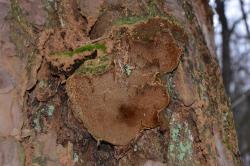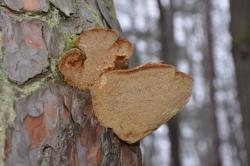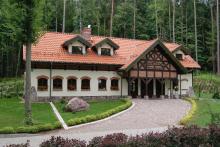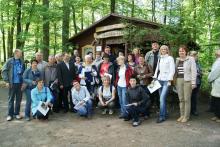 Asset Publisher
Asset Publisher
Polish forests
Poland is in the European lead, while concerning the area of all forests. They cover about 29,2 % of the country territory, and grow within the area of 9,1 million hectares. The overwhelming majority of the forests is state owned, of which almost 7,6 million hectares are managed by the State Forests National Forest Holding..
The number of Polish forest is still growing. The forestation rate of the country has increased from 21 % in 1945 to 29,2 % at the moment. Between 1995 and 2008, the forest area increased by 310 thousand ha. The basis for afforestation works is the "National Programme for Increasing the Forest Cover" (KPZL), assuming an increase of the forestation rate up to 30 % by 2020 and up to 33 % by 2050. Polish forests abound in flora, fauna and fungi. 65 % of the total number of animal species live there.
The forests grow in our country on poor soils, mainly because of the development of the agriculture in previous years. It influences the distribution of the types of the forest sites in Poland. Over 55 % of the forest areas is covered with coniferous forests. In other areas, there are forest sites, mainly the mixed ones. Their small part constitute alder and riparian forests – not more than 3 %.
In the years 1945 – 2011 the area of natural deciduous tree stands within the area of the State Forests National Forest Holding increased from 13 to 28,2 %.
Within the lowlands and uplands the most often occurring tee species is pine. It covers 64,3 % of the forest area of the State Forests National Forest Holding and 57,7 % of private and commune forests. In the mountains the predominant species is European spruce ( in the west) and European spruce with beech (in the east). Domination of pine is the result of carrying on sustainable forest management in the past. Once, the monocultures (crops or cultivations of one species) were the answer to the great demand of industry for wood. Such forests appeared to be quite fragile to climatic factors. They also were often the prey of pests' expansion.
In Polish forests, the share of other tree species, especially deciduous trees have been systematically increasing. The foresters have stepped aside from monocultures – that is why, they try to fit specific species of the forest stand to the natural stand, that would be proper for the given area. Thanks to that, in the years 1945 – 2011, the area of the deciduous tree stands within the lands of the State Forests National Forest Holding increased from 13 to 28,2 %. There occur more and more frequently the following tree species: oaks, ashes, maples, sycamore maples, elms, but also birches, beeches, alders, poplars, hornbeams, aspens, tilias and willows.
Our forests are the most often represented by the forest stands aged 40 to 80 years. The average age of the forest equals 60 years. More and more trees are of big size at the age over 80 years. Since the end of the Second World War, the forests' area has increased up to almost 1,85 million hectares.
Raport o stanie lasów w Polsce 2012
 Asset Publisher
Asset Publisher
Czyreń sosnowy (Phellinus pini) - grzybowy wróg królowej polskich lasów
Czyreń sosnowy (Phellinus pini) - grzybowy wróg królowej polskich lasów
Sosna pospolita (Pinus sylvestris) - królowa polskich drzew, porastająca ostępy leśne stanowi ok. 65% wszystkich drzew rosnących w naszych lasach. Już z daleka można ją dostrzec i łatwo odróżnić od innych drzew po charakterystycznej rudawej, spękanej korze. Właśnie na tym gatunku drzewa najczęściej występuje czyreń sosnowy.
Czyreń sosnowy to pasożyt, który zasiedla głównie starsze sosny. Pierwsze owocniki można dostrzec na sosnach osiągających wiek około 50 lat, a im starsze drzewa, tym większe prawdopodobieństwo spotkania na nich tego grzyba. Czyreń ten jest grzybem dość pospolitym. Jego owocniki są wieloletnie, występujące w ciągu całego roku. Ich charakterystyczny wygląd sprawia, że bez problemu można je odróżnić od owocników innych czyreni, a także od innych grzybów nadrzewnych.
Owocniki huby sosny, bo tak też nazywany jest czyreń sosnowy nie wpisują się w grupę grzybów jadalnych. Znaczenia tego grzyba możemy dopatrzeć się dopiero wtedy, gdy „pod lupę” weźmiemy działalność jego enzymów. Enzymy te przyczyniają się do powstania białej jamkowatej zgnilizny u porażonych przez czyrenia drzew. Przez taką działalność czyreń sosnowy doprowadza do niszczenia drzew, a co za tym idzie i drewna, dlatego z gospodarczego punktu widzenia jest on wrogiem człowieka. Drewno sosnowe to jeden z najważniejszych surowców, zarówno w budownictwie, meblarstwie, jak i w przemyśle celulozowym. Sosna pospolita to również znana od dawna roślina lecznicza. Wykonywany z jej pędów i igliwia olejek jest stosowany na różne dolegliwości. Ze względu na duże znaczenie sosny pospolitej, niszczący ją czyreń jest dla nas jednym z bardzo ważnych grzybów nadrzewnych.
Po mimo tego, że czyreń sosnowy ma perfekcyjnie opanowane porażanie drzew i rozkładanie drewna, to istnieją metody, które pozwalają na ograniczenie jego rozprzestrzeniania.
Z pomocą człowiekowi przychodzą tu, a może bardziej przylatują dzięcioły. Rozkładane przez czyrenia drewno jest idealnym miejscem, w którym ptaki te wykłuwają dziuple. To właśnie dzięki m.in. dziuplom można zlokalizować porażone przez czyrenia drzewa i zareagować na obecność tego intruza. Jest to jedno z działań, poza szeregiem czynności wykonywanych w celu pielęgnacji drzew w całym okresie ich rozwoju, służących utrzymaniu właściwego stanu sanitarnego w lasach.
Czyreń sosnowy tak samo jak inne grzyby odgrywa ważną rolę w przyrodzie. Podobnie jak pozostałe grzyby nadrzewne, rozkładając drewno przyczynia się do obiegu materii i przepływu energii w przyrodzie.


 fot. Paweł Fabijański
fot. Paweł Fabijański
 fot. Paweł Fabijański
fot. Paweł Fabijański
 fot. Paweł Fabijański
fot. Paweł Fabijański










